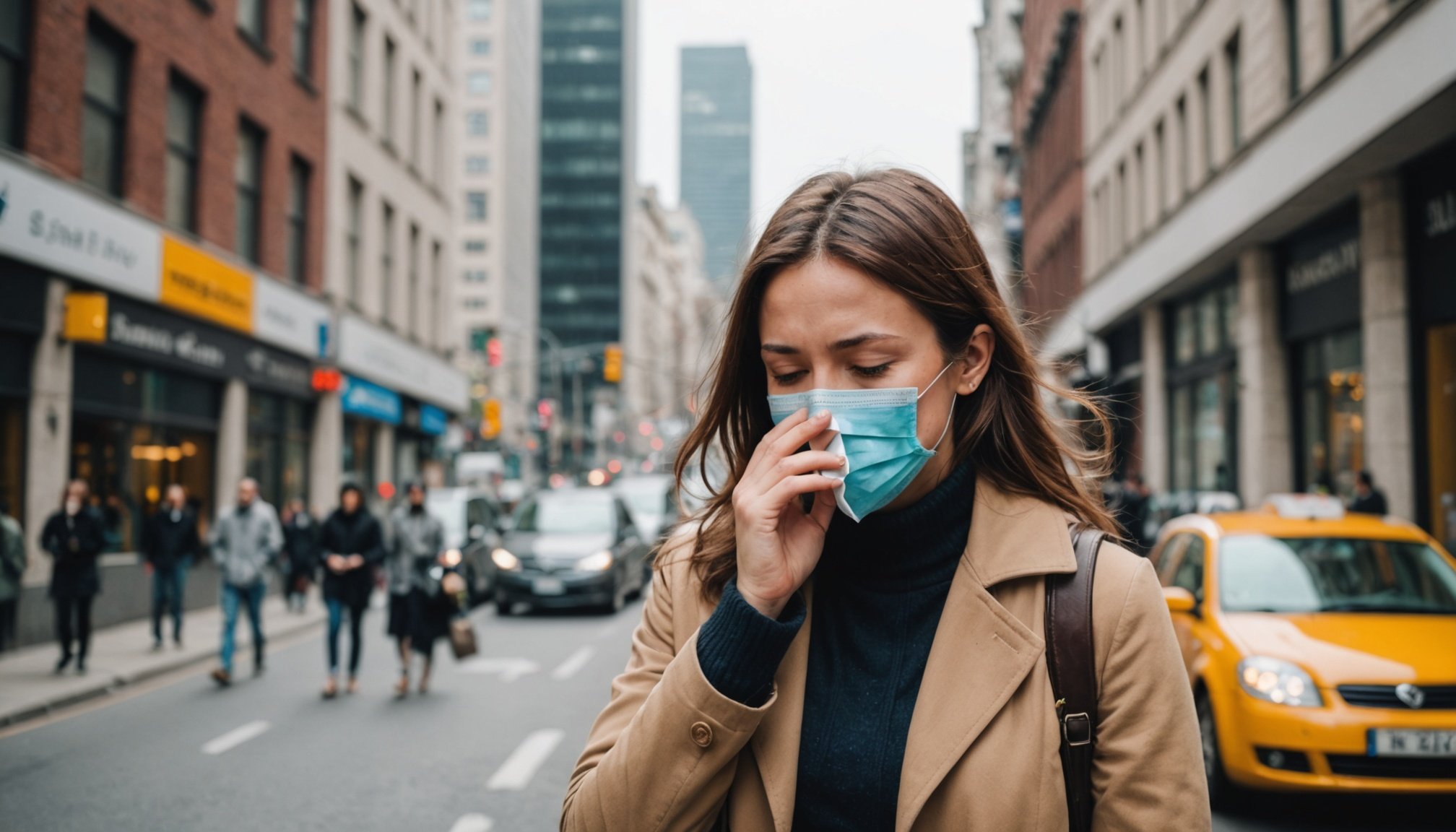Understanding Allergic Rhinitis
Allergic rhinitis, often referred to as hay fever, is a common condition affecting many individuals, particularly in urban environments. It occurs when the immune system mistakenly identifies harmless airborne substances, like pollen, as threats. This response causes inflammation of the nasal passages, leading to symptoms such as sneezing and itching.
In cities, urban allergy factors significantly contribute to the prevalence of allergic rhinitis. Urban areas often experience higher levels of pollution, which can exacerbate allergies. Vehicles and industrial activities release pollutants that combine with pollen, intensifying the body’s reaction. Moreover, urban warm-weather conditions can extend the allergy season, impacting individuals year-round.
This might interest you : Transforming colorectal surgery: how enhanced recovery after surgery (eras) reduces hospital stays
Understanding the distinction between seasonal and perennial allergic rhinitis is crucial. Seasonal allergic rhinitis is typically triggered during spring and summer by pollen. In contrast, perennial rhinitis occurs year-round and is usually due to indoor allergens such as dust mites or pet dander. Many urban inhabitants suffer from a combination of both, complicating their management of symptoms.
Navigating urban life with allergic rhinitis requires awareness and proactive strategies, making it imperative to recognize the different types and impacts of allergies. Through understanding, sufferers can better manage their conditions and improve their quality of life.
Additional reading : Discover the benefits: elevate your life with a gluten-free diet for non-celiac gluten sensitivity
Causes and Triggers of Allergic Rhinitis
Allergic rhinitis is primarily triggered when allergens are inhaled into the nasal passages, prompting the immune system to respond defensively. In urban environments, common allergens such as pollen, dust, and mold are prevalent. City dwellers are often surrounded by high amounts of these substances, significantly increasing the incidence of allergic rhinitis. Unlike rural areas, cities can present unique challenges due to their compact nature and pollution levels.
Pollution plays a substantial role in exacerbating allergic reactions. Urban pollution, consisting of vehicle emissions and industrial activities, combines with airborne allergens, aggravating symptoms. These pollutants can interact with allergens like pollen, intensifying their impact and leading to more severe reactions.
Seasonal variations of allergens are an important aspect to consider. During certain times of the year, like spring, pollen levels rise, leading to heightened exposure. Mold, however, might become more prominent during damp seasons or in poorly ventilated urban buildings. Understanding seasonal patterns is crucial for managing symptoms effectively.
Navigating an urban setting with the knowledge of these triggers enables sufferers to adopt preventative strategies, ultimately improving health and overall quality of life while living amidst urban allergens.
Diagnosis of Allergic Rhinitis
Understanding the necessity of a professional diagnosis for allergic rhinitis is critical for effective management. An accurate diagnosis helps determine the specific allergens causing symptoms and guides appropriate treatment plans. Many people experience symptoms like sneezing, itching, and congestion without realizing allergic rhinitis is the underlying cause, especially in urban settings where pollutants exacerbate conditions.
Common diagnostic tests include skin prick tests and blood tests, which identify specific allergen sensitivities. Skin prick tests involve placing a small amount of allergen on the skin and observing the reaction, while blood tests measure specific antibodies in the bloodstream. Both provide crucial insights into what triggers allergies in different individuals.
Urban dwellers have access to a range of local resources for allergy testing. Clinics and allergists in cities offer specialized services that cater to residents’ needs. Some clinics might conduct tests that reveal both seasonal and perennial allergies, considering the unique environmental factors in cities.
By engaging with professional medical services, sufferers can tailor their management strategies and navigate their symptoms with greater confidence. Awareness of local resources and potential allergens empowers individuals to seek timely intervention, improving their overall quality of life.
Local Resources for Assistance
Managing allergic rhinitis effectively involves leveraging local resources, especially in urban areas where symptoms can be more severe. Accessing a network of allergy specialists can provide personalized support and advice. Numerous clinics and specialized centres within cities offer comprehensive care, including thorough allergy testing and tailored treatment plans.
For those seeking community support, allergy support groups can be invaluable. These groups often meet regularly, providing a platform to share experiences, tips, and emotional support. They can also facilitate connections with experienced allergists, enhancing one’s understanding of personal triggers and management strategies.
City dwellers have an advantage when it comes to accessing educational resources, which can play a crucial role in managing allergic rhinitis. Libraries, community centres, and even online platforms often host workshops and seminars focused on allergy education. These events can be invaluable for learning about recent developments in allergy management and expanding one’s knowledge toolkit.
In tackling urban allergy challenges, utilizing available urban health resources can significantly empower individuals. By tapping into these community and professional supports, sufferers of allergic rhinitis can better navigate their condition and lead healthier, more comfortable lives.
Symptoms of Allergic Rhinitis
Allergic rhinitis symptoms can significantly impact daily urban living, presenting challenges to those affected. Typical symptoms include nasal congestion, sneezing, and itchy eyes, often resulting from inhaling allergens like pollen or dust prevalent in cities. These symptoms can be persistent and interfere with work and leisure activities, especially in compact urban spaces.
Urban life factors such as poor air quality can exacerbate these symptoms. Pollution from vehicles and industrial activities often intensifies allergic reactions, making it difficult for city dwellers to find relief. Additionally, the density of buildings can trap allergens, prolonging exposure and discomfort.
While common symptoms are well-known, there are rare symptoms that may be overlooked, such as fatigue or headaches. These can be mistakenly attributed to other causes, delaying appropriate allergy treatment. Being aware of these less recognized symptoms can aid in managing the condition more effectively.
Understanding these symptoms and how urban environments influence them is crucial for developing a comprehensive management plan. Recognizing the role of city living in exacerbating allergic rhinitis can guide individuals in seeking the right prevention and treatment strategies. Being mindful of the full spectrum of symptoms ensures a proactive approach to managing allergic rhinitis in urban settings.
Preventive Measures for Urban Dwellers
Adopting effective allergy prevention tips is essential for urban residents facing allergic rhinitis. One can employ several strategies to minimize exposure to urban allergens, such as incorporating air purifiers in homes to reduce indoor pollutants. Regular cleaning routines, like vacuuming with HEPA filters and washing bedding in hot water, can also decrease allergens such as dust mites.
Urban living strategies involve staying informed about local pollution and pollen levels. Weather monitoring apps can help urban dwellers plan activities when allergen levels are lower, mitigating prolonged exposure. Wearing face masks during high pollen days or when pollution is particularly high can further shield against airborne irritants.
Understanding the role of early intervention in managing symptoms is crucial. Engaging with these measures can limit the severity of allergic rhinitis experiences. Urbanites are known for their on-the-go lifestyles, so these strategies offer a practical approach to maintaining health amidst city life.
Awareness and practical applications, such as these suggestions, can dramatically improve the quality of life for those suffering from allergic rhinitis. Planning and preparation enable individuals to confront urban allergens head-on, ensuring their living environment remains as comfortable as possible.
Treatment Options for Allergic Rhinitis
Allergic rhinitis treatments provide relief for those grappling with symptoms, especially in urban environments. Over-the-counter medications, such as antihistamines and decongestants, are often the first option. They promptly ease symptoms like sneezing and congestion. However, these are typically best for mild to moderate cases.
When symptoms persist, prescription options come into play. Corticosteroid nasal sprays reduce inflammation directly in the nasal passages, offering significant relief. For severe cases, doctors might suggest combining multiple medications to address overlapping symptoms.
A long-term solution lies in immunotherapy, which gradually desensitizes the immune system to specific allergens. Available as allergy shots or sublingual tablets, this treatment can significantly reduce symptoms over time. While immunotherapy requires commitment, it addresses the root cause rather than just alleviating symptoms.
Individuals often benefit from a tailored treatment plan. By consulting healthcare professionals, sufferers can determine which combination of treatments suits them best. Such personalized strategies consider the intricacies of urban allergens and aim to improve the quality of life. Exploring these therapeutic avenues ensures a proactive approach in managing allergic rhinitis comprehensively.
Lifestyle Modifications for Better Management
Adapting to allergic rhinitis involves more than just medical interventions; lifestyle changes can significantly enhance urban allergy management. A well-rounded approach integrates diet and exercise, as nutrition influences immune response. A diet rich in antioxidants and omega-3 fatty acids can reduce inflammation and mitigate allergy symptoms. Regular physical activity boosts immunity and helps manage stress, a known allergy trigger.
Urban dwellers should not overlook the importance of mental health and stress management. High stress levels can exacerbate allergy symptoms, making relaxation techniques essential. Practices such as meditation, yoga, or deep breathing exercises can alleviate stress, offering a non-medical way to manage symptoms more effectively.
Developing a personalized allergy management plan empowers individuals to navigate urban allergens strategically. Customizing this plan involves identifying specific triggers and incorporating adjustments such as dietary changes, exercise routines, and stress-reduction strategies. Additionally, integrating tools like allergen tracking apps can help monitor exposures and plan daily activities accordingly.
These lifestyle modifications not only ease symptoms but also promote overall well-being. Embracing a proactive lifestyle approach enables urban residents to lead healthier, more comfortable lives despite the challenges of allergic rhinitis, ensuring they can fully enjoy their surroundings without constant discomfort.











